Impact of Individual Performance Related Pay on Employee Motivation
VerifiedAdded on 2021/02/19
|9
|2884
|14
Report
AI Summary
This report delves into the strategic approach of Human Resource Management (HRM), focusing on individual performance and its link to pay and motivation. The report explores the concept of Individual Performance Related Pay (PRP) and its implications, highlighting how it can stimulate higher levels of employee performance. It examines the advantages and disadvantages of PRP, including its influence on employee motivation, retention, and potential drawbacks such as reduced cooperation and demotivation. The report also discusses the role of motivation theories, such as Maslow's Hierarchy of Needs, in understanding employee behavior and the impact of IPRP in various organizational scenarios. The conclusion emphasizes the importance of aligning pay with individual performance to drive motivation and achieve organizational goals, while addressing potential issues that arise during implementation.

Assignment
Paraphrase This Document
Need a fresh take? Get an instant paraphrase of this document with our AI Paraphraser
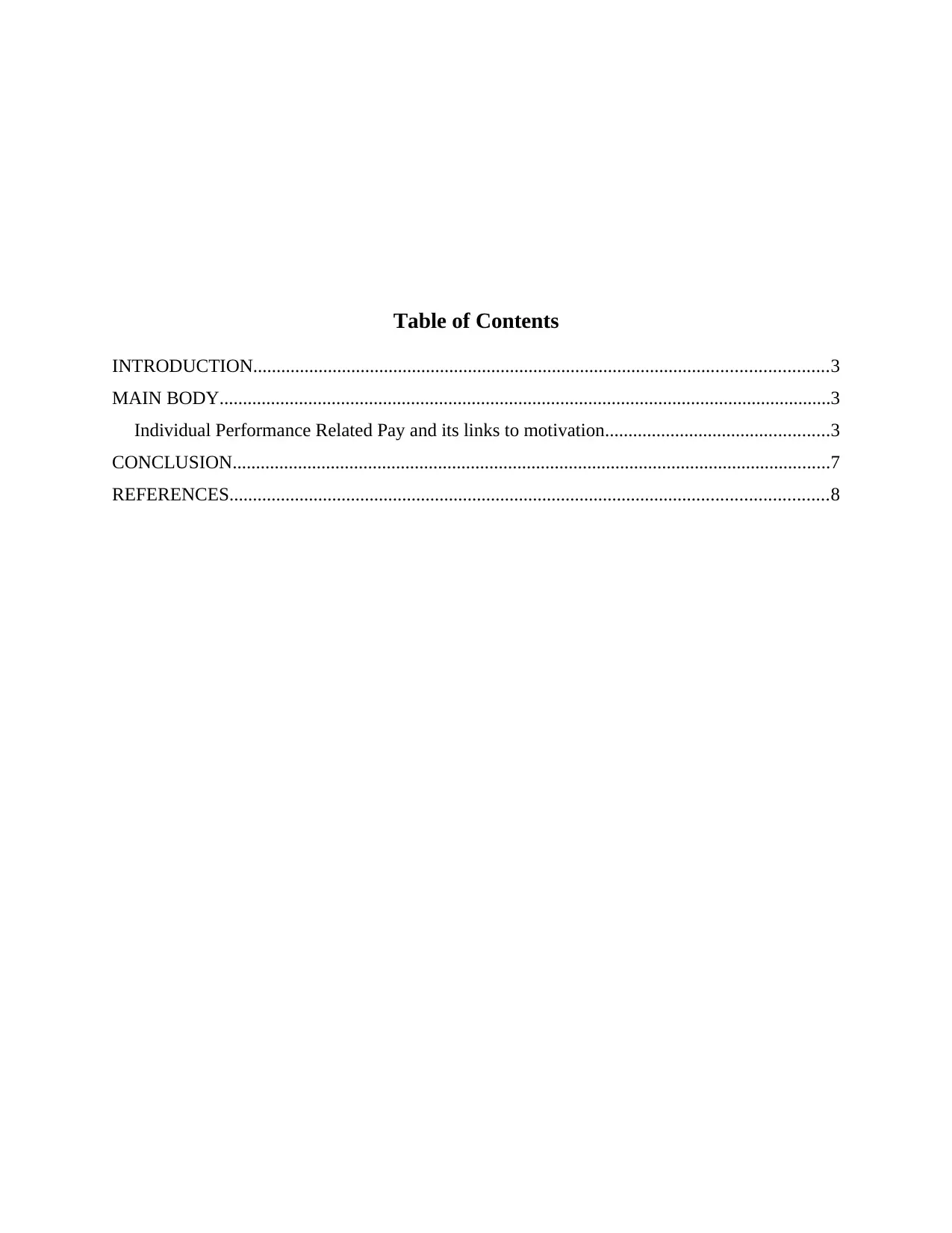
Table of Contents
INTRODUCTION...........................................................................................................................3
MAIN BODY...................................................................................................................................3
Individual Performance Related Pay and its links to motivation................................................3
CONCLUSION................................................................................................................................7
REFERENCES................................................................................................................................8
INTRODUCTION...........................................................................................................................3
MAIN BODY...................................................................................................................................3
Individual Performance Related Pay and its links to motivation................................................3
CONCLUSION................................................................................................................................7
REFERENCES................................................................................................................................8
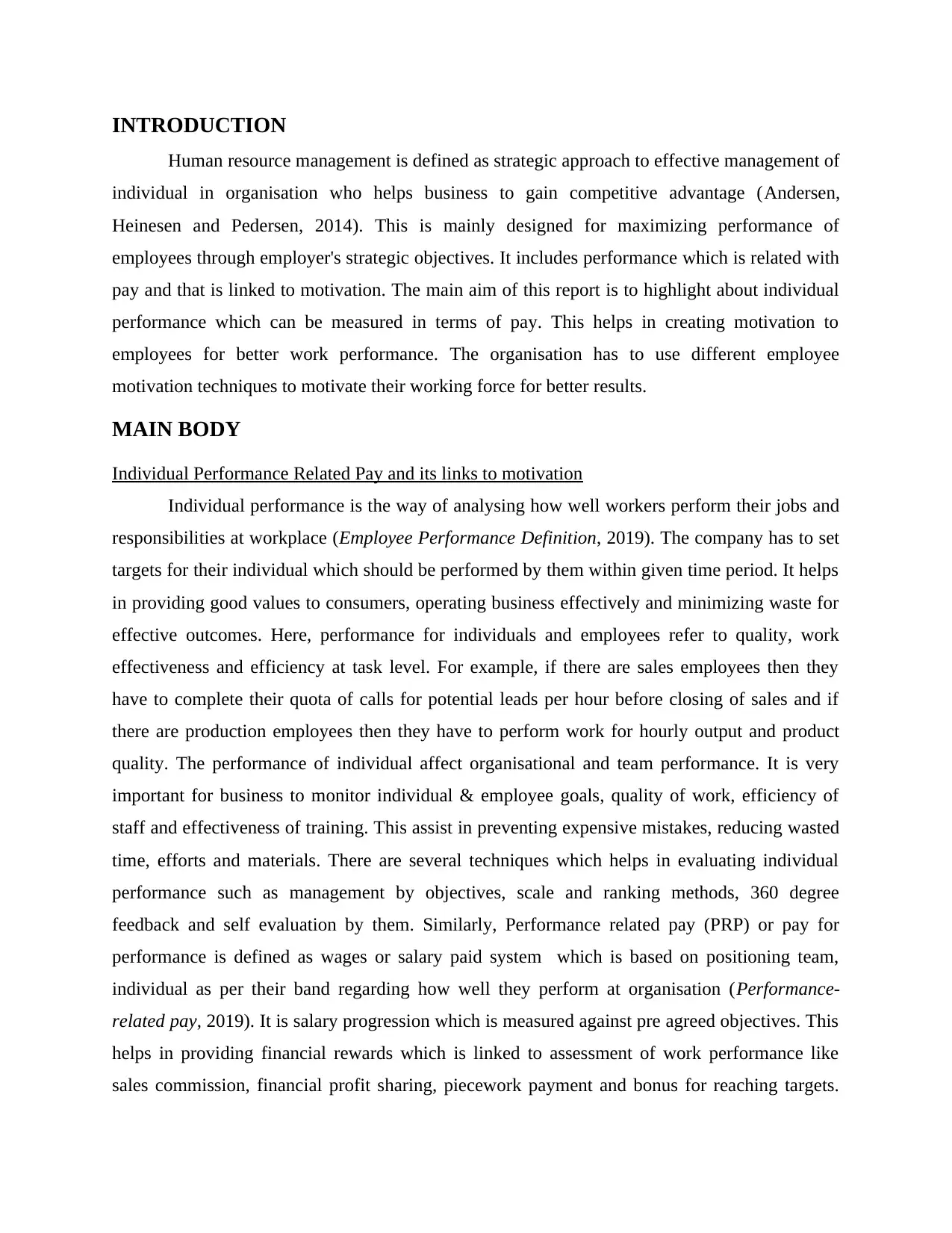
INTRODUCTION
Human resource management is defined as strategic approach to effective management of
individual in organisation who helps business to gain competitive advantage (Andersen,
Heinesen and Pedersen, 2014). This is mainly designed for maximizing performance of
employees through employer's strategic objectives. It includes performance which is related with
pay and that is linked to motivation. The main aim of this report is to highlight about individual
performance which can be measured in terms of pay. This helps in creating motivation to
employees for better work performance. The organisation has to use different employee
motivation techniques to motivate their working force for better results.
MAIN BODY
Individual Performance Related Pay and its links to motivation
Individual performance is the way of analysing how well workers perform their jobs and
responsibilities at workplace (Employee Performance Definition, 2019). The company has to set
targets for their individual which should be performed by them within given time period. It helps
in providing good values to consumers, operating business effectively and minimizing waste for
effective outcomes. Here, performance for individuals and employees refer to quality, work
effectiveness and efficiency at task level. For example, if there are sales employees then they
have to complete their quota of calls for potential leads per hour before closing of sales and if
there are production employees then they have to perform work for hourly output and product
quality. The performance of individual affect organisational and team performance. It is very
important for business to monitor individual & employee goals, quality of work, efficiency of
staff and effectiveness of training. This assist in preventing expensive mistakes, reducing wasted
time, efforts and materials. There are several techniques which helps in evaluating individual
performance such as management by objectives, scale and ranking methods, 360 degree
feedback and self evaluation by them. Similarly, Performance related pay (PRP) or pay for
performance is defined as wages or salary paid system which is based on positioning team,
individual as per their band regarding how well they perform at organisation (Performance-
related pay, 2019). It is salary progression which is measured against pre agreed objectives. This
helps in providing financial rewards which is linked to assessment of work performance like
sales commission, financial profit sharing, piecework payment and bonus for reaching targets.
Human resource management is defined as strategic approach to effective management of
individual in organisation who helps business to gain competitive advantage (Andersen,
Heinesen and Pedersen, 2014). This is mainly designed for maximizing performance of
employees through employer's strategic objectives. It includes performance which is related with
pay and that is linked to motivation. The main aim of this report is to highlight about individual
performance which can be measured in terms of pay. This helps in creating motivation to
employees for better work performance. The organisation has to use different employee
motivation techniques to motivate their working force for better results.
MAIN BODY
Individual Performance Related Pay and its links to motivation
Individual performance is the way of analysing how well workers perform their jobs and
responsibilities at workplace (Employee Performance Definition, 2019). The company has to set
targets for their individual which should be performed by them within given time period. It helps
in providing good values to consumers, operating business effectively and minimizing waste for
effective outcomes. Here, performance for individuals and employees refer to quality, work
effectiveness and efficiency at task level. For example, if there are sales employees then they
have to complete their quota of calls for potential leads per hour before closing of sales and if
there are production employees then they have to perform work for hourly output and product
quality. The performance of individual affect organisational and team performance. It is very
important for business to monitor individual & employee goals, quality of work, efficiency of
staff and effectiveness of training. This assist in preventing expensive mistakes, reducing wasted
time, efforts and materials. There are several techniques which helps in evaluating individual
performance such as management by objectives, scale and ranking methods, 360 degree
feedback and self evaluation by them. Similarly, Performance related pay (PRP) or pay for
performance is defined as wages or salary paid system which is based on positioning team,
individual as per their band regarding how well they perform at organisation (Performance-
related pay, 2019). It is salary progression which is measured against pre agreed objectives. This
helps in providing financial rewards which is linked to assessment of work performance like
sales commission, financial profit sharing, piecework payment and bonus for reaching targets.
⊘ This is a preview!⊘
Do you want full access?
Subscribe today to unlock all pages.

Trusted by 1+ million students worldwide
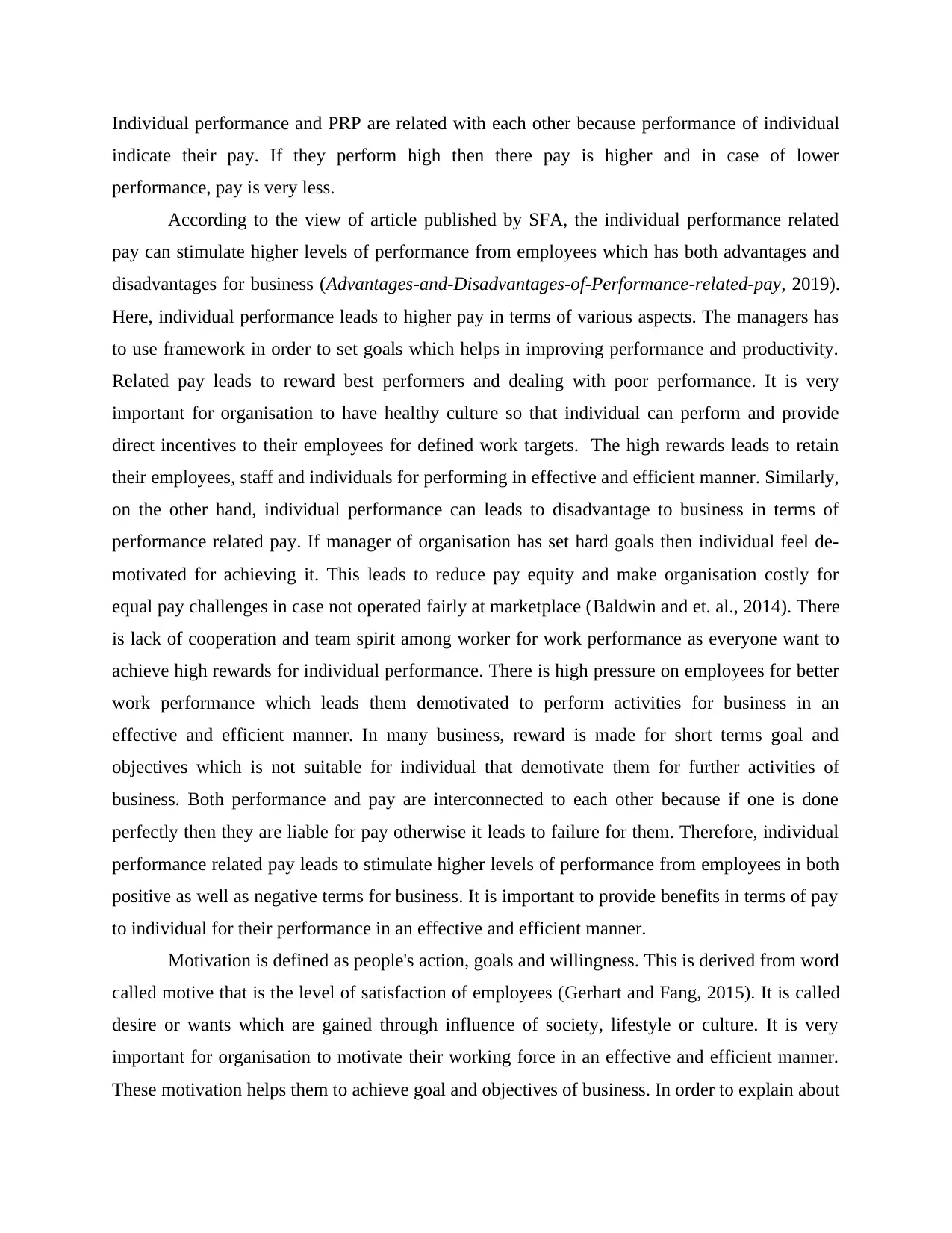
Individual performance and PRP are related with each other because performance of individual
indicate their pay. If they perform high then there pay is higher and in case of lower
performance, pay is very less.
According to the view of article published by SFA, the individual performance related
pay can stimulate higher levels of performance from employees which has both advantages and
disadvantages for business (Advantages-and-Disadvantages-of-Performance-related-pay, 2019).
Here, individual performance leads to higher pay in terms of various aspects. The managers has
to use framework in order to set goals which helps in improving performance and productivity.
Related pay leads to reward best performers and dealing with poor performance. It is very
important for organisation to have healthy culture so that individual can perform and provide
direct incentives to their employees for defined work targets. The high rewards leads to retain
their employees, staff and individuals for performing in effective and efficient manner. Similarly,
on the other hand, individual performance can leads to disadvantage to business in terms of
performance related pay. If manager of organisation has set hard goals then individual feel de-
motivated for achieving it. This leads to reduce pay equity and make organisation costly for
equal pay challenges in case not operated fairly at marketplace (Baldwin and et. al., 2014). There
is lack of cooperation and team spirit among worker for work performance as everyone want to
achieve high rewards for individual performance. There is high pressure on employees for better
work performance which leads them demotivated to perform activities for business in an
effective and efficient manner. In many business, reward is made for short terms goal and
objectives which is not suitable for individual that demotivate them for further activities of
business. Both performance and pay are interconnected to each other because if one is done
perfectly then they are liable for pay otherwise it leads to failure for them. Therefore, individual
performance related pay leads to stimulate higher levels of performance from employees in both
positive as well as negative terms for business. It is important to provide benefits in terms of pay
to individual for their performance in an effective and efficient manner.
Motivation is defined as people's action, goals and willingness. This is derived from word
called motive that is the level of satisfaction of employees (Gerhart and Fang, 2015). It is called
desire or wants which are gained through influence of society, lifestyle or culture. It is very
important for organisation to motivate their working force in an effective and efficient manner.
These motivation helps them to achieve goal and objectives of business. In order to explain about
indicate their pay. If they perform high then there pay is higher and in case of lower
performance, pay is very less.
According to the view of article published by SFA, the individual performance related
pay can stimulate higher levels of performance from employees which has both advantages and
disadvantages for business (Advantages-and-Disadvantages-of-Performance-related-pay, 2019).
Here, individual performance leads to higher pay in terms of various aspects. The managers has
to use framework in order to set goals which helps in improving performance and productivity.
Related pay leads to reward best performers and dealing with poor performance. It is very
important for organisation to have healthy culture so that individual can perform and provide
direct incentives to their employees for defined work targets. The high rewards leads to retain
their employees, staff and individuals for performing in effective and efficient manner. Similarly,
on the other hand, individual performance can leads to disadvantage to business in terms of
performance related pay. If manager of organisation has set hard goals then individual feel de-
motivated for achieving it. This leads to reduce pay equity and make organisation costly for
equal pay challenges in case not operated fairly at marketplace (Baldwin and et. al., 2014). There
is lack of cooperation and team spirit among worker for work performance as everyone want to
achieve high rewards for individual performance. There is high pressure on employees for better
work performance which leads them demotivated to perform activities for business in an
effective and efficient manner. In many business, reward is made for short terms goal and
objectives which is not suitable for individual that demotivate them for further activities of
business. Both performance and pay are interconnected to each other because if one is done
perfectly then they are liable for pay otherwise it leads to failure for them. Therefore, individual
performance related pay leads to stimulate higher levels of performance from employees in both
positive as well as negative terms for business. It is important to provide benefits in terms of pay
to individual for their performance in an effective and efficient manner.
Motivation is defined as people's action, goals and willingness. This is derived from word
called motive that is the level of satisfaction of employees (Gerhart and Fang, 2015). It is called
desire or wants which are gained through influence of society, lifestyle or culture. It is very
important for organisation to motivate their working force in an effective and efficient manner.
These motivation helps them to achieve goal and objectives of business. In order to explain about
Paraphrase This Document
Need a fresh take? Get an instant paraphrase of this document with our AI Paraphraser
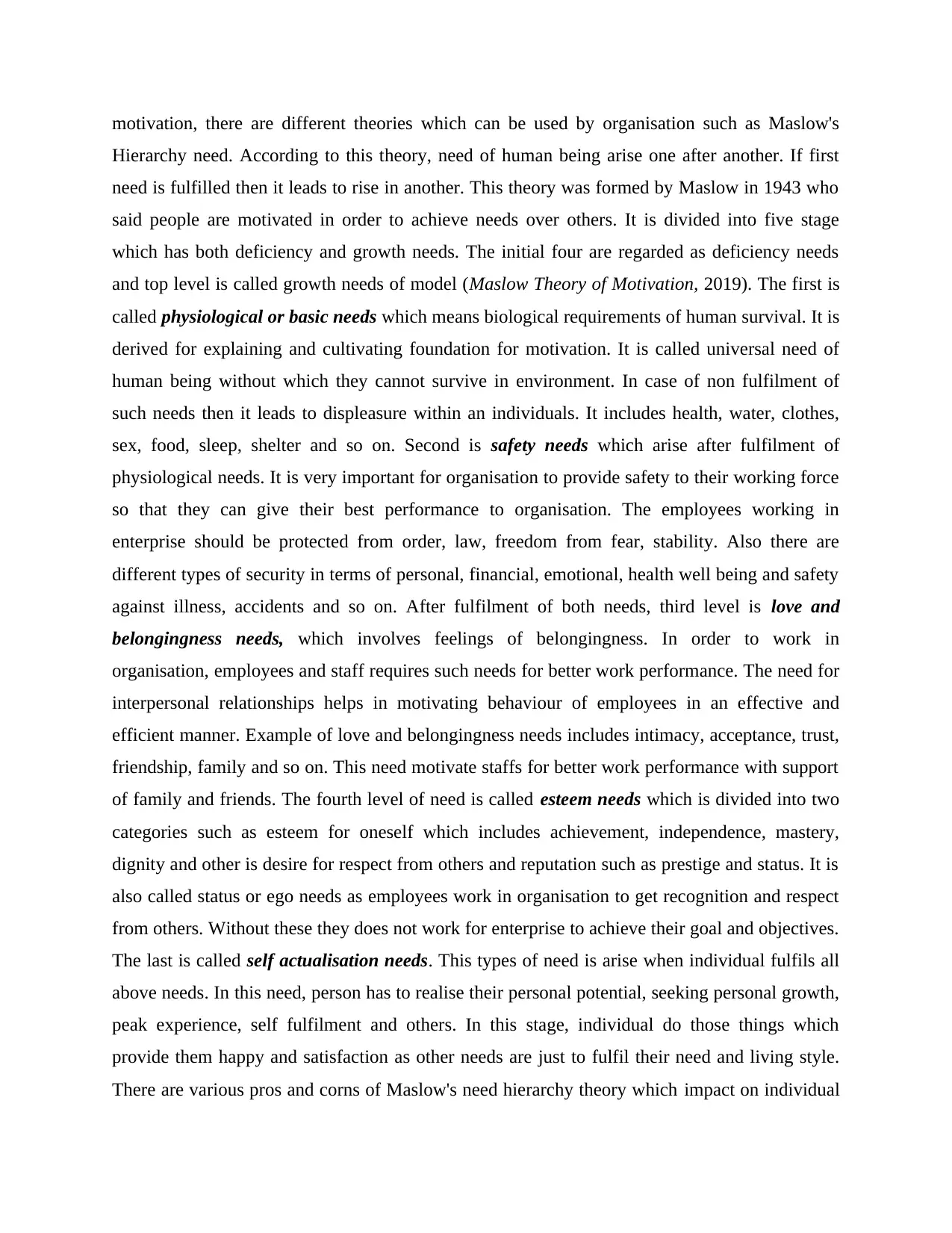
motivation, there are different theories which can be used by organisation such as Maslow's
Hierarchy need. According to this theory, need of human being arise one after another. If first
need is fulfilled then it leads to rise in another. This theory was formed by Maslow in 1943 who
said people are motivated in order to achieve needs over others. It is divided into five stage
which has both deficiency and growth needs. The initial four are regarded as deficiency needs
and top level is called growth needs of model (Maslow Theory of Motivation, 2019). The first is
called physiological or basic needs which means biological requirements of human survival. It is
derived for explaining and cultivating foundation for motivation. It is called universal need of
human being without which they cannot survive in environment. In case of non fulfilment of
such needs then it leads to displeasure within an individuals. It includes health, water, clothes,
sex, food, sleep, shelter and so on. Second is safety needs which arise after fulfilment of
physiological needs. It is very important for organisation to provide safety to their working force
so that they can give their best performance to organisation. The employees working in
enterprise should be protected from order, law, freedom from fear, stability. Also there are
different types of security in terms of personal, financial, emotional, health well being and safety
against illness, accidents and so on. After fulfilment of both needs, third level is love and
belongingness needs, which involves feelings of belongingness. In order to work in
organisation, employees and staff requires such needs for better work performance. The need for
interpersonal relationships helps in motivating behaviour of employees in an effective and
efficient manner. Example of love and belongingness needs includes intimacy, acceptance, trust,
friendship, family and so on. This need motivate staffs for better work performance with support
of family and friends. The fourth level of need is called esteem needs which is divided into two
categories such as esteem for oneself which includes achievement, independence, mastery,
dignity and other is desire for respect from others and reputation such as prestige and status. It is
also called status or ego needs as employees work in organisation to get recognition and respect
from others. Without these they does not work for enterprise to achieve their goal and objectives.
The last is called self actualisation needs. This types of need is arise when individual fulfils all
above needs. In this need, person has to realise their personal potential, seeking personal growth,
peak experience, self fulfilment and others. In this stage, individual do those things which
provide them happy and satisfaction as other needs are just to fulfil their need and living style.
There are various pros and corns of Maslow's need hierarchy theory which impact on individual
Hierarchy need. According to this theory, need of human being arise one after another. If first
need is fulfilled then it leads to rise in another. This theory was formed by Maslow in 1943 who
said people are motivated in order to achieve needs over others. It is divided into five stage
which has both deficiency and growth needs. The initial four are regarded as deficiency needs
and top level is called growth needs of model (Maslow Theory of Motivation, 2019). The first is
called physiological or basic needs which means biological requirements of human survival. It is
derived for explaining and cultivating foundation for motivation. It is called universal need of
human being without which they cannot survive in environment. In case of non fulfilment of
such needs then it leads to displeasure within an individuals. It includes health, water, clothes,
sex, food, sleep, shelter and so on. Second is safety needs which arise after fulfilment of
physiological needs. It is very important for organisation to provide safety to their working force
so that they can give their best performance to organisation. The employees working in
enterprise should be protected from order, law, freedom from fear, stability. Also there are
different types of security in terms of personal, financial, emotional, health well being and safety
against illness, accidents and so on. After fulfilment of both needs, third level is love and
belongingness needs, which involves feelings of belongingness. In order to work in
organisation, employees and staff requires such needs for better work performance. The need for
interpersonal relationships helps in motivating behaviour of employees in an effective and
efficient manner. Example of love and belongingness needs includes intimacy, acceptance, trust,
friendship, family and so on. This need motivate staffs for better work performance with support
of family and friends. The fourth level of need is called esteem needs which is divided into two
categories such as esteem for oneself which includes achievement, independence, mastery,
dignity and other is desire for respect from others and reputation such as prestige and status. It is
also called status or ego needs as employees work in organisation to get recognition and respect
from others. Without these they does not work for enterprise to achieve their goal and objectives.
The last is called self actualisation needs. This types of need is arise when individual fulfils all
above needs. In this need, person has to realise their personal potential, seeking personal growth,
peak experience, self fulfilment and others. In this stage, individual do those things which
provide them happy and satisfaction as other needs are just to fulfil their need and living style.
There are various pros and corns of Maslow's need hierarchy theory which impact on individual
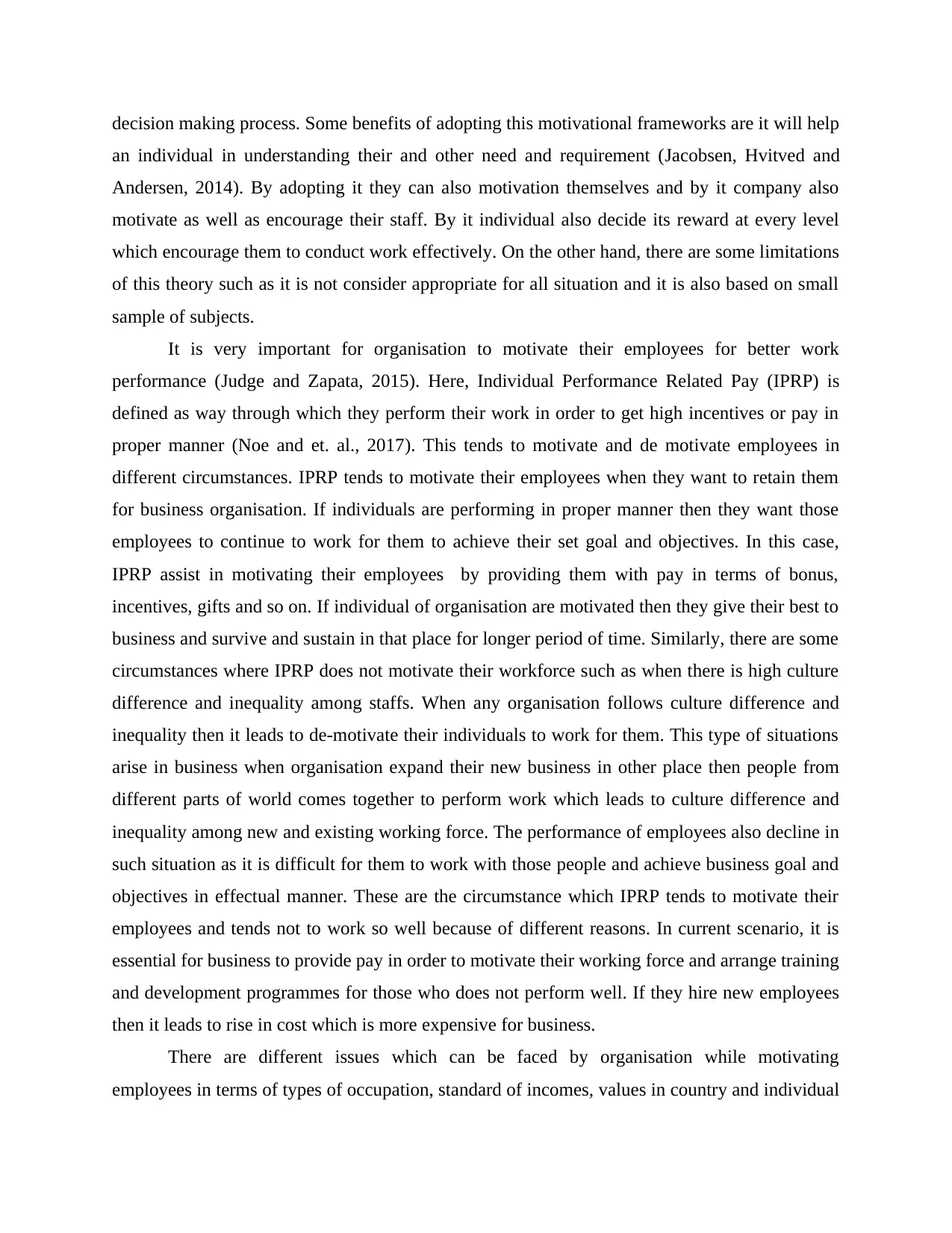
decision making process. Some benefits of adopting this motivational frameworks are it will help
an individual in understanding their and other need and requirement (Jacobsen, Hvitved and
Andersen, 2014). By adopting it they can also motivation themselves and by it company also
motivate as well as encourage their staff. By it individual also decide its reward at every level
which encourage them to conduct work effectively. On the other hand, there are some limitations
of this theory such as it is not consider appropriate for all situation and it is also based on small
sample of subjects.
It is very important for organisation to motivate their employees for better work
performance (Judge and Zapata, 2015). Here, Individual Performance Related Pay (IPRP) is
defined as way through which they perform their work in order to get high incentives or pay in
proper manner (Noe and et. al., 2017). This tends to motivate and de motivate employees in
different circumstances. IPRP tends to motivate their employees when they want to retain them
for business organisation. If individuals are performing in proper manner then they want those
employees to continue to work for them to achieve their set goal and objectives. In this case,
IPRP assist in motivating their employees by providing them with pay in terms of bonus,
incentives, gifts and so on. If individual of organisation are motivated then they give their best to
business and survive and sustain in that place for longer period of time. Similarly, there are some
circumstances where IPRP does not motivate their workforce such as when there is high culture
difference and inequality among staffs. When any organisation follows culture difference and
inequality then it leads to de-motivate their individuals to work for them. This type of situations
arise in business when organisation expand their new business in other place then people from
different parts of world comes together to perform work which leads to culture difference and
inequality among new and existing working force. The performance of employees also decline in
such situation as it is difficult for them to work with those people and achieve business goal and
objectives in effectual manner. These are the circumstance which IPRP tends to motivate their
employees and tends not to work so well because of different reasons. In current scenario, it is
essential for business to provide pay in order to motivate their working force and arrange training
and development programmes for those who does not perform well. If they hire new employees
then it leads to rise in cost which is more expensive for business.
There are different issues which can be faced by organisation while motivating
employees in terms of types of occupation, standard of incomes, values in country and individual
an individual in understanding their and other need and requirement (Jacobsen, Hvitved and
Andersen, 2014). By adopting it they can also motivation themselves and by it company also
motivate as well as encourage their staff. By it individual also decide its reward at every level
which encourage them to conduct work effectively. On the other hand, there are some limitations
of this theory such as it is not consider appropriate for all situation and it is also based on small
sample of subjects.
It is very important for organisation to motivate their employees for better work
performance (Judge and Zapata, 2015). Here, Individual Performance Related Pay (IPRP) is
defined as way through which they perform their work in order to get high incentives or pay in
proper manner (Noe and et. al., 2017). This tends to motivate and de motivate employees in
different circumstances. IPRP tends to motivate their employees when they want to retain them
for business organisation. If individuals are performing in proper manner then they want those
employees to continue to work for them to achieve their set goal and objectives. In this case,
IPRP assist in motivating their employees by providing them with pay in terms of bonus,
incentives, gifts and so on. If individual of organisation are motivated then they give their best to
business and survive and sustain in that place for longer period of time. Similarly, there are some
circumstances where IPRP does not motivate their workforce such as when there is high culture
difference and inequality among staffs. When any organisation follows culture difference and
inequality then it leads to de-motivate their individuals to work for them. This type of situations
arise in business when organisation expand their new business in other place then people from
different parts of world comes together to perform work which leads to culture difference and
inequality among new and existing working force. The performance of employees also decline in
such situation as it is difficult for them to work with those people and achieve business goal and
objectives in effectual manner. These are the circumstance which IPRP tends to motivate their
employees and tends not to work so well because of different reasons. In current scenario, it is
essential for business to provide pay in order to motivate their working force and arrange training
and development programmes for those who does not perform well. If they hire new employees
then it leads to rise in cost which is more expensive for business.
There are different issues which can be faced by organisation while motivating
employees in terms of types of occupation, standard of incomes, values in country and individual
⊘ This is a preview!⊘
Do you want full access?
Subscribe today to unlock all pages.

Trusted by 1+ million students worldwide
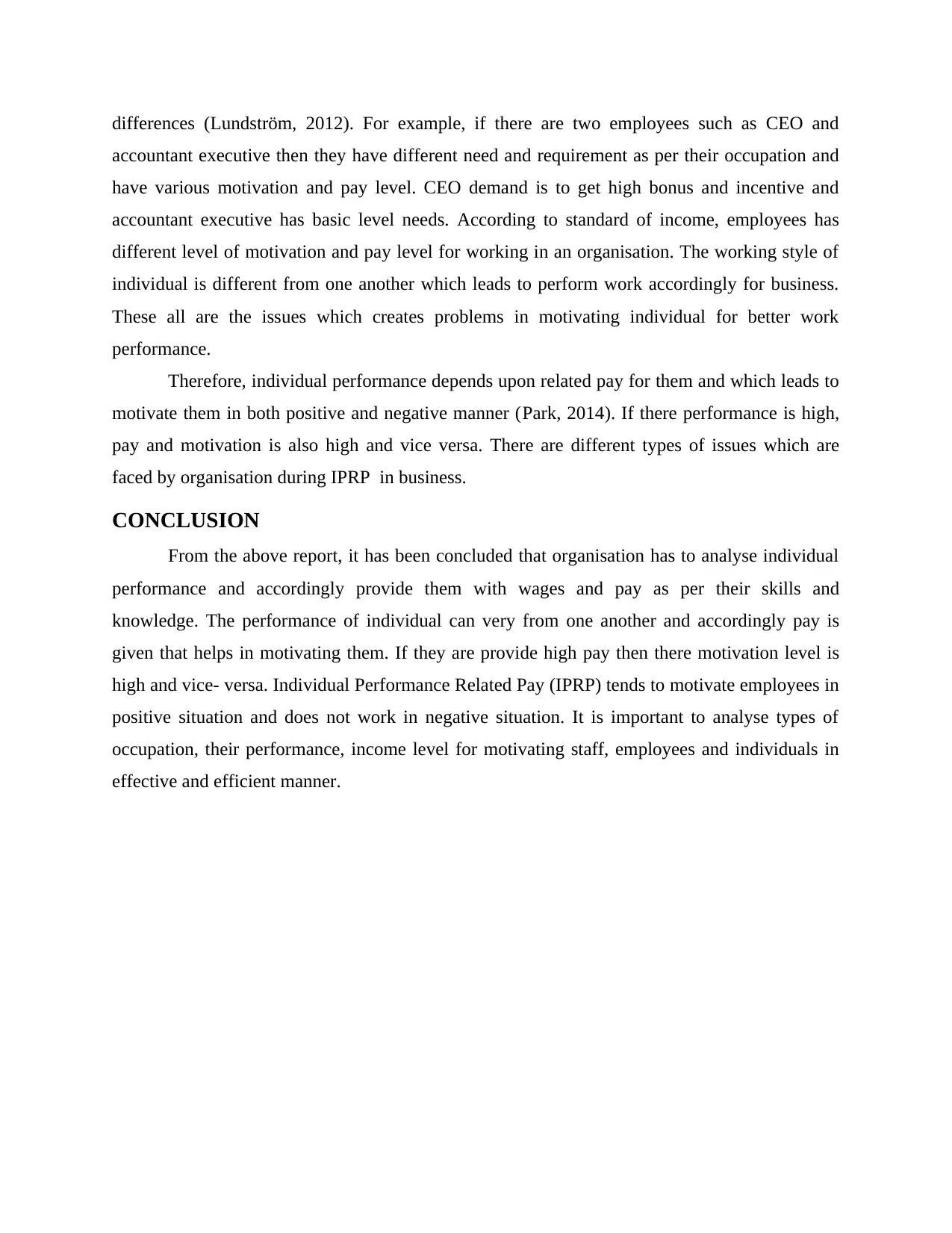
differences (Lundström, 2012). For example, if there are two employees such as CEO and
accountant executive then they have different need and requirement as per their occupation and
have various motivation and pay level. CEO demand is to get high bonus and incentive and
accountant executive has basic level needs. According to standard of income, employees has
different level of motivation and pay level for working in an organisation. The working style of
individual is different from one another which leads to perform work accordingly for business.
These all are the issues which creates problems in motivating individual for better work
performance.
Therefore, individual performance depends upon related pay for them and which leads to
motivate them in both positive and negative manner (Park, 2014). If there performance is high,
pay and motivation is also high and vice versa. There are different types of issues which are
faced by organisation during IPRP in business.
CONCLUSION
From the above report, it has been concluded that organisation has to analyse individual
performance and accordingly provide them with wages and pay as per their skills and
knowledge. The performance of individual can very from one another and accordingly pay is
given that helps in motivating them. If they are provide high pay then there motivation level is
high and vice- versa. Individual Performance Related Pay (IPRP) tends to motivate employees in
positive situation and does not work in negative situation. It is important to analyse types of
occupation, their performance, income level for motivating staff, employees and individuals in
effective and efficient manner.
accountant executive then they have different need and requirement as per their occupation and
have various motivation and pay level. CEO demand is to get high bonus and incentive and
accountant executive has basic level needs. According to standard of income, employees has
different level of motivation and pay level for working in an organisation. The working style of
individual is different from one another which leads to perform work accordingly for business.
These all are the issues which creates problems in motivating individual for better work
performance.
Therefore, individual performance depends upon related pay for them and which leads to
motivate them in both positive and negative manner (Park, 2014). If there performance is high,
pay and motivation is also high and vice versa. There are different types of issues which are
faced by organisation during IPRP in business.
CONCLUSION
From the above report, it has been concluded that organisation has to analyse individual
performance and accordingly provide them with wages and pay as per their skills and
knowledge. The performance of individual can very from one another and accordingly pay is
given that helps in motivating them. If they are provide high pay then there motivation level is
high and vice- versa. Individual Performance Related Pay (IPRP) tends to motivate employees in
positive situation and does not work in negative situation. It is important to analyse types of
occupation, their performance, income level for motivating staff, employees and individuals in
effective and efficient manner.
Paraphrase This Document
Need a fresh take? Get an instant paraphrase of this document with our AI Paraphraser
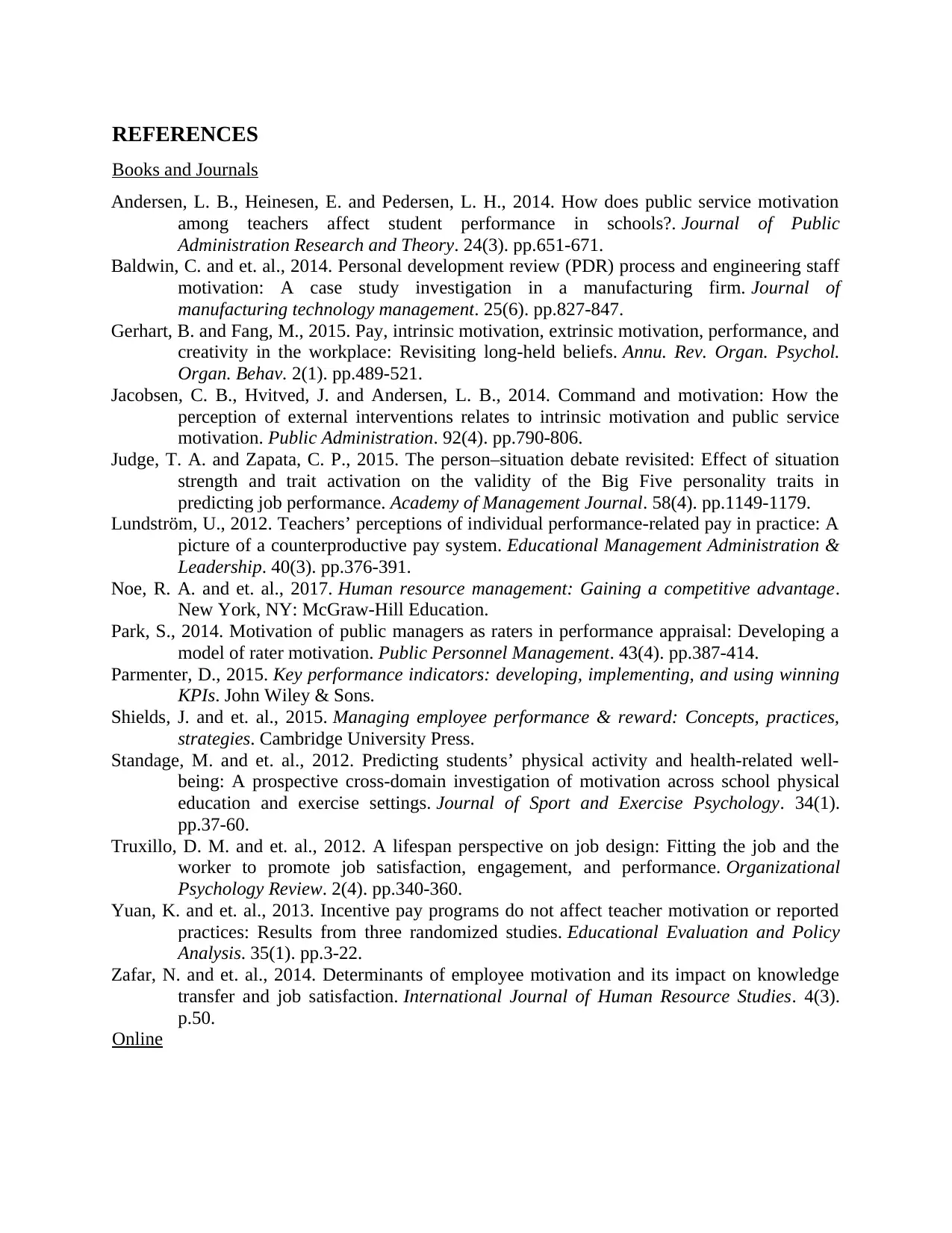
REFERENCES
Books and Journals
Andersen, L. B., Heinesen, E. and Pedersen, L. H., 2014. How does public service motivation
among teachers affect student performance in schools?. Journal of Public
Administration Research and Theory. 24(3). pp.651-671.
Baldwin, C. and et. al., 2014. Personal development review (PDR) process and engineering staff
motivation: A case study investigation in a manufacturing firm. Journal of
manufacturing technology management. 25(6). pp.827-847.
Gerhart, B. and Fang, M., 2015. Pay, intrinsic motivation, extrinsic motivation, performance, and
creativity in the workplace: Revisiting long-held beliefs. Annu. Rev. Organ. Psychol.
Organ. Behav. 2(1). pp.489-521.
Jacobsen, C. B., Hvitved, J. and Andersen, L. B., 2014. Command and motivation: How the
perception of external interventions relates to intrinsic motivation and public service
motivation. Public Administration. 92(4). pp.790-806.
Judge, T. A. and Zapata, C. P., 2015. The person–situation debate revisited: Effect of situation
strength and trait activation on the validity of the Big Five personality traits in
predicting job performance. Academy of Management Journal. 58(4). pp.1149-1179.
Lundström, U., 2012. Teachers’ perceptions of individual performance-related pay in practice: A
picture of a counterproductive pay system. Educational Management Administration &
Leadership. 40(3). pp.376-391.
Noe, R. A. and et. al., 2017. Human resource management: Gaining a competitive advantage.
New York, NY: McGraw-Hill Education.
Park, S., 2014. Motivation of public managers as raters in performance appraisal: Developing a
model of rater motivation. Public Personnel Management. 43(4). pp.387-414.
Parmenter, D., 2015. Key performance indicators: developing, implementing, and using winning
KPIs. John Wiley & Sons.
Shields, J. and et. al., 2015. Managing employee performance & reward: Concepts, practices,
strategies. Cambridge University Press.
Standage, M. and et. al., 2012. Predicting students’ physical activity and health-related well-
being: A prospective cross-domain investigation of motivation across school physical
education and exercise settings. Journal of Sport and Exercise Psychology. 34(1).
pp.37-60.
Truxillo, D. M. and et. al., 2012. A lifespan perspective on job design: Fitting the job and the
worker to promote job satisfaction, engagement, and performance. Organizational
Psychology Review. 2(4). pp.340-360.
Yuan, K. and et. al., 2013. Incentive pay programs do not affect teacher motivation or reported
practices: Results from three randomized studies. Educational Evaluation and Policy
Analysis. 35(1). pp.3-22.
Zafar, N. and et. al., 2014. Determinants of employee motivation and its impact on knowledge
transfer and job satisfaction. International Journal of Human Resource Studies. 4(3).
p.50.
Online
Books and Journals
Andersen, L. B., Heinesen, E. and Pedersen, L. H., 2014. How does public service motivation
among teachers affect student performance in schools?. Journal of Public
Administration Research and Theory. 24(3). pp.651-671.
Baldwin, C. and et. al., 2014. Personal development review (PDR) process and engineering staff
motivation: A case study investigation in a manufacturing firm. Journal of
manufacturing technology management. 25(6). pp.827-847.
Gerhart, B. and Fang, M., 2015. Pay, intrinsic motivation, extrinsic motivation, performance, and
creativity in the workplace: Revisiting long-held beliefs. Annu. Rev. Organ. Psychol.
Organ. Behav. 2(1). pp.489-521.
Jacobsen, C. B., Hvitved, J. and Andersen, L. B., 2014. Command and motivation: How the
perception of external interventions relates to intrinsic motivation and public service
motivation. Public Administration. 92(4). pp.790-806.
Judge, T. A. and Zapata, C. P., 2015. The person–situation debate revisited: Effect of situation
strength and trait activation on the validity of the Big Five personality traits in
predicting job performance. Academy of Management Journal. 58(4). pp.1149-1179.
Lundström, U., 2012. Teachers’ perceptions of individual performance-related pay in practice: A
picture of a counterproductive pay system. Educational Management Administration &
Leadership. 40(3). pp.376-391.
Noe, R. A. and et. al., 2017. Human resource management: Gaining a competitive advantage.
New York, NY: McGraw-Hill Education.
Park, S., 2014. Motivation of public managers as raters in performance appraisal: Developing a
model of rater motivation. Public Personnel Management. 43(4). pp.387-414.
Parmenter, D., 2015. Key performance indicators: developing, implementing, and using winning
KPIs. John Wiley & Sons.
Shields, J. and et. al., 2015. Managing employee performance & reward: Concepts, practices,
strategies. Cambridge University Press.
Standage, M. and et. al., 2012. Predicting students’ physical activity and health-related well-
being: A prospective cross-domain investigation of motivation across school physical
education and exercise settings. Journal of Sport and Exercise Psychology. 34(1).
pp.37-60.
Truxillo, D. M. and et. al., 2012. A lifespan perspective on job design: Fitting the job and the
worker to promote job satisfaction, engagement, and performance. Organizational
Psychology Review. 2(4). pp.340-360.
Yuan, K. and et. al., 2013. Incentive pay programs do not affect teacher motivation or reported
practices: Results from three randomized studies. Educational Evaluation and Policy
Analysis. 35(1). pp.3-22.
Zafar, N. and et. al., 2014. Determinants of employee motivation and its impact on knowledge
transfer and job satisfaction. International Journal of Human Resource Studies. 4(3).
p.50.
Online
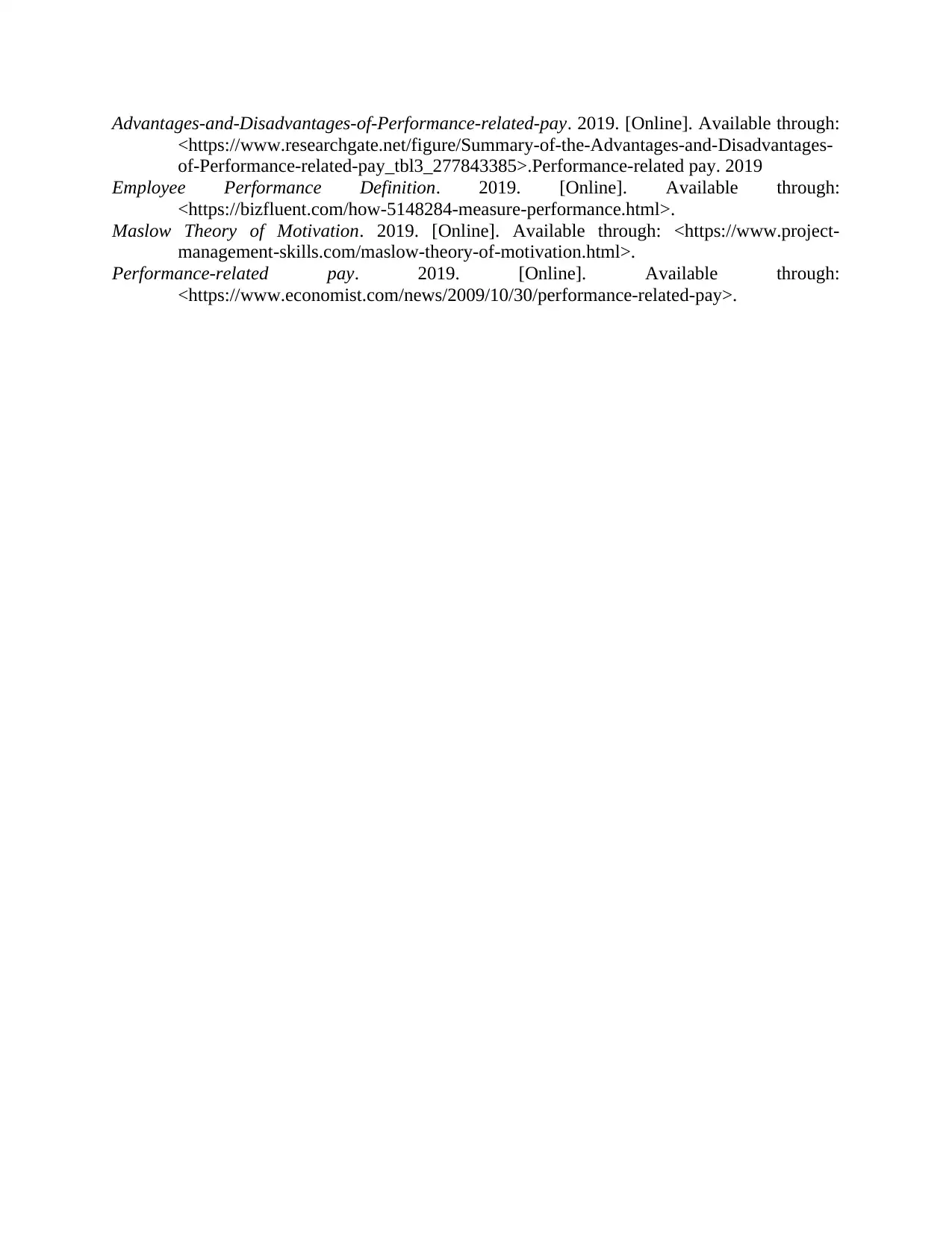
Advantages-and-Disadvantages-of-Performance-related-pay. 2019. [Online]. Available through:
<https://www.researchgate.net/figure/Summary-of-the-Advantages-and-Disadvantages-
of-Performance-related-pay_tbl3_277843385>.Performance-related pay. 2019
Employee Performance Definition. 2019. [Online]. Available through:
<https://bizfluent.com/how-5148284-measure-performance.html>.
Maslow Theory of Motivation. 2019. [Online]. Available through: <https://www.project-
management-skills.com/maslow-theory-of-motivation.html>.
Performance-related pay. 2019. [Online]. Available through:
<https://www.economist.com/news/2009/10/30/performance-related-pay>.
<https://www.researchgate.net/figure/Summary-of-the-Advantages-and-Disadvantages-
of-Performance-related-pay_tbl3_277843385>.Performance-related pay. 2019
Employee Performance Definition. 2019. [Online]. Available through:
<https://bizfluent.com/how-5148284-measure-performance.html>.
Maslow Theory of Motivation. 2019. [Online]. Available through: <https://www.project-
management-skills.com/maslow-theory-of-motivation.html>.
Performance-related pay. 2019. [Online]. Available through:
<https://www.economist.com/news/2009/10/30/performance-related-pay>.
⊘ This is a preview!⊘
Do you want full access?
Subscribe today to unlock all pages.

Trusted by 1+ million students worldwide
1 out of 9
Related Documents
Your All-in-One AI-Powered Toolkit for Academic Success.
+13062052269
info@desklib.com
Available 24*7 on WhatsApp / Email
![[object Object]](/_next/static/media/star-bottom.7253800d.svg)
Unlock your academic potential
Copyright © 2020–2025 A2Z Services. All Rights Reserved. Developed and managed by ZUCOL.





